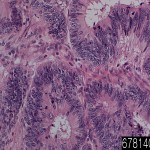| Product name | Colon adenocarcinoma MD |
| Cat. No. | 0062000A |
| No. of samples | 1 |
| Description | colon adenocarcinoma MD Age/Sex : 56/M |
| Price | 197 EUR |
| 260 USD | |
| 170 GBP |
Product Related Literature
As a consequence of mutations in that Wnt signaling pathway to increase the signaling activity artificially most commonly, colon cancer is a disease derived from epithelial cells in the mucous membrane of the colon or rectum of the gastrointestinal tract. Mutations can be acquired or inherited, to generate stem cells in intestinal crypts most likely. Mutant gene is the APC to produce APC protein most often in colon cancer gene of all. In the “brake” of accumulation catenin protein, a non-APC, tail – – tail APC protein catenin accumulates to high levels in the nucleus move to (drive), a general importance to update the system and bind DNA Sometimes, expressing cell differentiation, can lead to cancer in inappropriately high level when you activate the transcription of a gene. APC is mutated in the majority of certain types of cancer, colon cancer, cancer, blocking mutations in other genes with similar functions or decomposition, its tail – tail for catenin is a (CTNNB1) – NKD1 or, AXIN2, TCF7L2, ADR as AXIN1 catenin mutation is increasing.
Beyond the defects in Wnt signaling-APC-β-catenin signaling pathway, must be performed to convert the cancer cells other mutations. The monitor cell division usually, if there is defect in Wnt pathway thereof, P53 protein production differences, kill cells by TP53 gene. Finally, the cell line, we get the organization turns TP53 mutations and gene from adenoma to invasive cancer. Delete (in colorectal cancer (sometimes mutations are not a protective another protein named BAX is p53 gene coding), DCC and TGF-tail is a apoptotic protein disabling other colorectal cancer in general ). And has a mutation that inactivated at least half of the TGF-tail colon cancer. In many cases, a protein called Smad DCC followed when it is not TGF-tail excluded people, is the deletion of chromosomal segments in colorectal cancer.
Several genes is a cancer gene – They are over-expressed in colon cancer. For example, a protein gene encodes, usually, PI3K KRAS, and RAF may acquire a mutation that results in the activation of cell proliferation and stimulates cells to divide in response to growth factors. General primary KRAS mutations lead to borderline lesion or self-limiting hyperplasia, chronological order of mutations is important sometimes, if it occurs APC mutation after the previous, in many cases, to progress to cancer. PTEN, tumor suppression, can usually inhibits the PI3K, disabling and sometimes mutations.
I made it clear that colon cancer is ultra-mutation, comprehensive analysis, genome-wide can be separated clearly in tumor types not super mutation. In addition to the above inactivating mutation for the gene that contains a super-mutation and ARID1A, SOX9, ATM CTNNB1, FAM123B mutations also sample and oncogenes. Genetic event that displays a mutant of BRAF and, TGFBR2, MSH3, MSH6, SLC9A9, TCF7L2 ACVR2A, progression through a separate set of super-mutant tumor. The common theme in both types of tumors among these genes, it is the participation of TGF-tail signaling pathway, and WNT lead to increased activity of the major factor MYC, of colon cancer in order. Usually, it has been reported from the analysis of the tissue taken by biopsy or surgery in the histology of the tumor. Usually, a description of the grade and type of cell is included in the pathology report. The most common type of cancer of the colon cells are adenocarcinoma accounts for 95% of the cases. Common type of other less, includes lymphoma and squamous cell carcinoma. Tend to be meaning ekzofitichen, that the tumor grows outward from the part of the intestinal wall tumors (cecum and ascending colon) right. Not causing the blockage of feces very rarely, this is symptoms of anemia, such as such. Tumor on the left side, allowing you to make is very similar to the ring napkin, which allows that a butterfly has to offer for flights caliber thin tend to be circumference and, Yes.
It is a malignant epithelial tumor of glandular epithelium from adenocarcinoma, colorectal mucosa. Wall, it penetrates into the penetration of the muscle layer of the mucosa muscularis propria and submucosa from there. Tumor cells were described to hold the lumen pluristratification, multiple, irregular tubular structure, the stroma was reduced (the side of the “parallel”). Mucus (colloid) adenocarcinoma, poorly differentiated – was entering the stroma to generate a large pool of (space of “empty” optically) mucus / colloid, sometimes, tumor cells are mucus and discohesive. When remaining in the tumor cells, the fluid pushes the core to the outer periphery – “a signet-ring cell”. Depending on the predominant pattern of mucosecretion and polymorphism gland architecture, cell, be presented three times of differentiation can be adenocarcinoma: well, poorly differentiated and moderately.
Details of histogenesis of FA is still unknown, highly discussion. Usually in the heterogeneous than peritumoral, adenocarcinoma, and due to the malignant transformation of primitive cells that can exhibit the characteristics of goblet cells cell differentiation Clara, II lung alveolar cells, cell surface bronchioles, or bronchial gland cells, possible. High-grade top FA, poorly differentiated variants have been described, it was moderately differentiated tumors or enough. It is possible to find FA similar to tissue is mixed with a collection of primitive osteoblast-like cells. The presence of cell blastomatous exacerbate prognosis significantly, in this case, tumors of two phases can be classified as a form of pulmonary blastoma. The FA, may occur in combination with adenocarcinoma other forms of lung cancer, other embodiments in particular. In addition, there seems to be a clear link implementation of lung cancer. I reported the case of synthetic small cell lung cancer cells that are similar to those of carcinoid tumor components and the FA are involved, and show the complexity and diversity unique tissue formation of lung cancer and cell differentiation.

